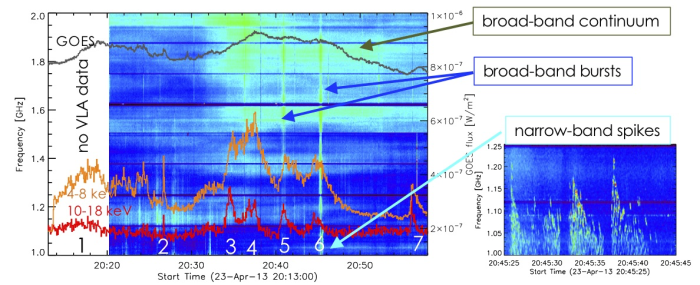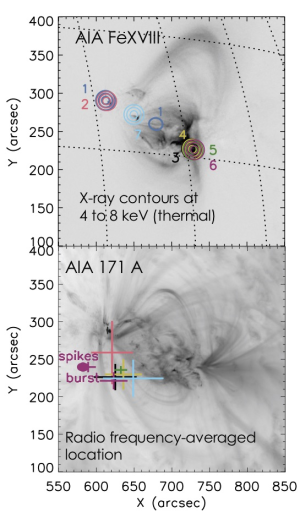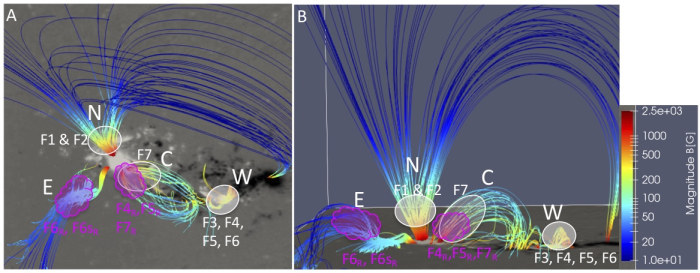Manifold Nonthermality
| Nugget | |
|---|---|
| Number: | 417 |
| 1st Author: | Marina BATTAGLIA et al. |
| 2nd Author: | |
| Published: | 27 September 2021 |
| Next Nugget: | Coronal Structure |
| Previous Nugget: | X-Rays from a Type I Radio Burst |
Introduction
Signatures of flare-accelerated electrons can be found both at X-ray and radio wavelengths. Hence, the two wavelengths are highly complementary diagnostically and combining observations at both helps us get a better understanding of where electrons are accelerated and transported in solar flares. In this work (Ref. [1]) we combined RHESSI X-ray observations of a series of microflares (GOES A3.4 to B1.6) with highly sensitive radio data from the Karl G. Jansky Very Large Array. This facility has high spectral, spatial, and temporal resolution. The radio data show a veritable zoo of different radio emissions, co-temporal but not co-spatial with the X-ray sources. It has long been known that the locations of X-ray and radio sources often to not coincide, even when the timing of the emissions does, but why is this? Are electrons transported far away from the main acceleration site? Is there a secondary acceleration site, triggered by the primary flare? Or is it all coincidence?
Flare overview
Figure 1 shows an overview of the temporal and radio spectral evolution of the dataset. A cross-power VLA dynamic spectrum is shown, overlaid with RHESSI X-ray lightcurves at 4-8 keV and 10-18 keV. A cross-power spectrum is an image-weighted approximation to the familiar full-Sun spectrograms used for longer wavelengths. Flares were identified as individual peaks in the 10-18 keV lightcurve and labelled 1 to 7. Some of the most interesting features in the radio dynamic spectrum are highlighted in the Figure.

Relative locations of X-ray and Radio emissions
Figure 2 shows the relative locations of X-ray sources and radio sources. The X-ray flares originated from at least three different locations within the active region. RHESSI users should take note of the fact, that for flare 1 and 4 it was even possible to image two flares at the same time, from different locations. The radio sources, however, originated from entirely different locations, at first glance not connected at all to where we observe the X-ray flares. Some seem to coincide with faint loops and a fan-like structure seen in the AIA 171 A wavelength channel. Not all flares could be imaged with the VLA with sufficient confidence since their emissions were weak, even for the highly sensitive VLA, hence we will focus on flares 4,5, 6, and 7 in the following.

Interpretation
How can we explain this large separation between the X-ray sources and the associated radio sources? To answer the question, one can look to NLFFF extrapolations, as presented in Figure 3. There are three main loops systems in the west of the active region (W), the center (C), the north (N) and the east (E). Based on this, we found three different explanations:
1) The emissions are from the same energetic electron population, observed within the same magnetic loop (C). This is the case for flare 7.
2) The emissions are from the same energetic electron population that was accelerated during the main flare at region W, but some of the electrons were transported far away from the primary acceleration site either through direct injection into an overlying loop system or through cross-field diffusion. (Flares 4 and 5)
3) The emissions of the burst and the spikes during Flare 6 are from electrons that were accelerated at a secondary acceleration site (E), while the flare itself happened more than 100 arcseconds away near region W. Such sympathetic flares have been known to even occur between active regions and it has been suggested that the regions involved could be connected by large scale loops that are perturbed by the original flare which results in reconnection events far away from the original flare site. If such loops exist, our model did not pick them up.

The observations presented here show that even microflares can display a surprising complexity and that secondary acceleration may be much more common than typically believed but at present we can only see the signatures of such electrons in high sensitivity radio observations.
Co-Authors
Rohit SHARMA, Yingjie LUO, Bin CHEN, Sijie YU, and Säm KRUCKER